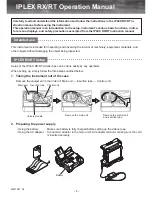
SECTION 2 – OPERATING INSTRUCTIONS 2-7
the vented water and prevent it from running down inside the instrument or into the sensor
cavity.
The test cell and instrument are now ready to begin a compressive strength test.
Running a Test
Pressure Control
This section describes how the Pump Regulator and Pressure Relief Valves work together for
automatic pressure control.
As the test cell is heated, the pressure will increase. When the pressure exceeds the control
pressure upper limit, the relief valve will open and pressure will be reduced. If the heating rate
is reduced, as during the temperature transition from a ramp to a soak profile, the pressure in
the test cell may begin to fall. If the pressure falls below the control pressure lower limit, the
pump will stroke and bring the pressure back within the established limits.
The pump and relief valve will have a “dead band” or hysteresis in their operation. If the relief
valve is set to relieve at 4000 psig, it may open at 4000 psig, but may not close until the
pressure falls to, for example, 3900 psig. This 100 psig differential between opening and
closing is called the “dead band” or hysteresis. As another example, the pump may be set to
begin pumping if the pressure falls to 3000 psig, but the pressure may reach, for example,
3100 psig before the pump stops. This 100 psig differential between the start pressure and the
stop pressure is also known as “dead band” or hysteresis. If the upper and lower set points
are set too close together, this “dead band” may overlap and cause the system to go into a
continuous oscillation where the pump tries to increase pressure and the relief valve releases
all the pressure the pump is able to build. The solution to this problem is to decrease the
lower set point or raise the upper set point or both.
Starting the Test
1.
Turn the POWER switch to the ON position
2.
Open the PRESSURE valve left/right on the cylinder to be pressured.
3.
Turn the PUMP switch to the ON position and rotate the PUMP REGULATOR valve
clockwise until the cylinder reaches the desired pressure set point. If the cylinder will not
reach the pressure set point, turn the PRESSURE RELIEF valve clockwise until the
cylinder develops the desired pressure.
4.
Turn the PRESSURE RELIEF valve counterclockwise slowly until the test cell pressure
begins to drop slightly below the set point. Continue turning the regulator knob slowly
until the pressure in the test cell equals the upper limit of the desired test pressure.
5.
Turn the HEATER switch to ON. (The heater and pump will not start until the program
start up is initiated through the controller.)
Summary of Contents for CHANDLER ENGINEERING Twin UCA 4262
Page 6: ...P 2 PREFACE This page is intentionally left blank...
Page 10: ...1 4 SECTION 1 INSTALLATION This page is intentionally left blank...
Page 20: ...2 10 SECTION 2 OPERATING INSTRUCTIONS This page is intentionally left blank...
Page 24: ...3 4 SECTION 3 MAINTENANCE AND SERVICING This page is intentionally left blank...
Page 28: ...4 4 SECTION 4 TROUBLESHOOTING GUIDE This page is intentionally left blank...
Page 32: ......
Page 33: ...CHANDLER ENGINEERING...
Page 34: ......
Page 37: ......
Page 38: ...CHANDLER ENGINEERING...
Page 39: ......
Page 40: ...CHANDLER ENGINEERING...
















































